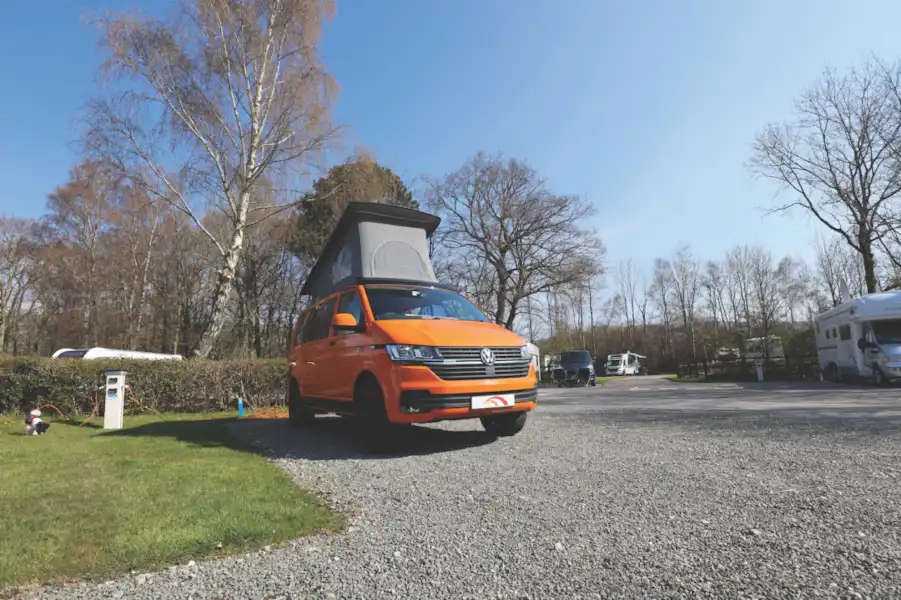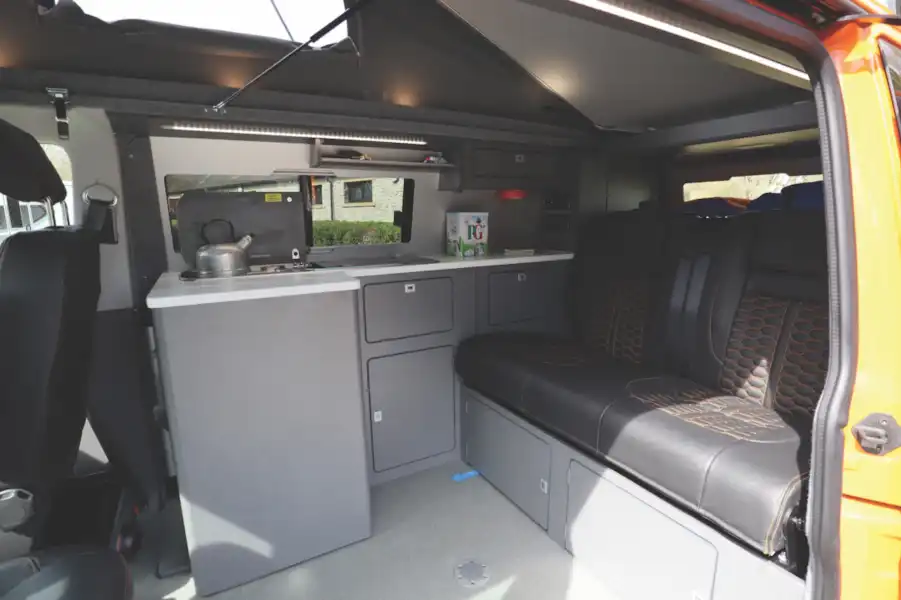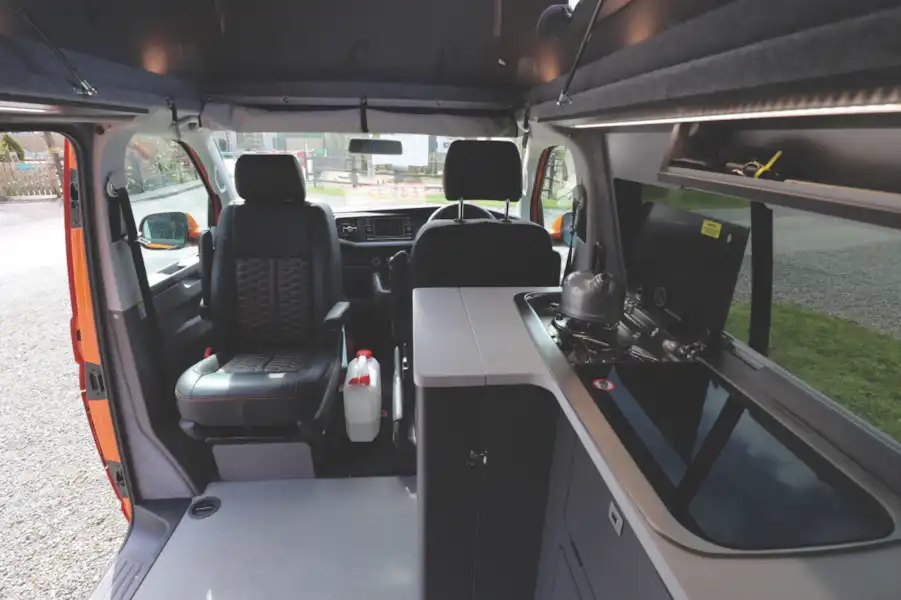Key Features
| Model Year | 2021 |
| Class | Rising Roof |
| Base Vehicle | Volkswagen T6.1 |
| Price From (£) | 58,995 |
| Length (m) | 4.90 |
| Berths | 4 |
| Belted Seats | 4 |
| Main Layout | Campervan |
At a glance
Full review
Words and photos: Geneve Brand
Whether it’s clothes or music, fashions come and go. And, just like any other fad, what’s hot and what’s not in the campervan world changes over time. Think back to the original vee-dub hippy wagons of the 1960s and 70s when eye-catching two-tone paintwork and pop-top roofs were all the rage.
Fast-forward to the 1980s and the rage for beige inside and out was, well… quite unfathomable. No wonder the shift towards palm tree decals and pina colada curtains in the 1990s was welcomed.
With all that colour going on, it’s no surprise white was the most common base vehicle option, either.
Moving into the noughties, grey became the way of it inside while metallic paint largely put pay to club tropicana themes, thankfully.
Colour choices, however, were pretty muted by today’s standards, with grey, black, red, dark blue or dark green being the only real alternatives to white, while two-tone was definitely off the options menu.
Interestingly, pop-top roofs massively fell out of favour for a couple of decades, too, with people preferring a high-top camper, possibly fitted with a roof bed.
Today, we seem to have come full circle. Funky colours for the exterior are back with a vengeance, and that’s reflected in the wide range of colours Volkswagen offers on its T6.1. Metallic paint is still popular but solid paint is really making a resurgence, too.
Now, if you choose a traditional colour like red or blue, you’ll be able to pick from a whole pallet of shades and paint types. Many of these colours are available as standard from VW, too.
Of course, pop-tops dominate the market again today. In fact, in a sea of brightly coloured pop-top VW T6.1 campers on Hillside’s forecourt, my campervan, which was in for its annual habitation service, was the only high-top in sight!
So, if we’ve come full circle since the 1960s, have we seen it all now? Well, no – because there’s a new kid on the block: the 4x4 campervan.
Like most other fashions, who knows how it got started but the crux of it is that the demand for off-road-capable campervans nowadays is a real headline.
Perhaps it’s because of the base vehicle choices available these days. In the past, if you wanted a decent off-roader you could sleep in, options were pretty much limited to a Land Rover with a roof tent or a big pick-up truck with a dismountable camping pod.
However, with mainstream panel van manufacturers like VW and Mercedes now offering really good four-wheel drive options, one can certainly see the appeal of specifying a 4x4 campervan.
Volkswagen’s 4Motion isn’t new, though. Instead, it would seem its sudden rise to stardom story is more akin to the Floss dance – you know, it only takes one kid on YouTube and the next thing, it’s a global sensation.
In the UK, that kid was Rolling Homes. Back in 2019, it launched its Expedition campervan at the Birmingham NEC Caravan and Motorhome Show. Even with an eye-watering price tag (£76k), it sold on the first day of the show.
It was certainly a talking point, too, and we at Campervan HQ noticed a sudden rise in enquiries about off-road campervans following the show. Clearly, manufacturers experienced that, too, and naturally responded.
As an experiment, Hillside built a 4x4 camper to take to the Caravan, Camping and Motorhome Show in February 2020. Just like the Rolling Homes Expedition which had debuted here, Hillside’s camper also sold instantly and interest from showgoers was through the roof.
What’s interesting is that the VW 4Motion is not new and Hillside has always offered this base vehicle as an option to its customers, in the same way that you might specify an engine upgrade or automatic gearbox.
The trouble is that VW’s four-wheel drive Transporter does not look like an off-roader when it rolls out of the factory. In an ordinary colour and with regular road tyres, it looks just like any other VW T6.1. And that’s not what you want when you order an off-road campervan, is it?
The reason the Rolling Homes Expedition was so eye-catching was because it was bright orange, had roo-bars big enough to take on an elephant, great big knobbly all-terrain tyres and very expensive bucket seats, to mention just a few features.
Had it been a regular fresh-out-the-factory VW 4Motion panel van, with all the appeal of a dreary people carrier with a ‘Baby on board’ sticker in the window, it’s unlikely anyone would have given it a second glance.
So, in a nutshell, following the success of its ‘Birchover Classic on a 4Motion’, as it was dubbed when it launched at the NEC last year, Hillside has taken the clever decision to make this a campervan in its own right, with its own name – the Birchover All-Motion.
This streamlined approach provides transparency and makes things simple for potential buyers. If you want an off-roader and you spot this on Hillside’s forecourt, what you see is what you get, as pretty much everything is included in the basic price.
Since the 4Motion is already four-wheel drive, Hillside starts its rugged campervan transformation by adding all the aesthetic stuff VW forgot about, as well as a few practical elements.
That starts with an Eibach lift kit, which raises the height of the vehicle by 35mm to give extra ground clearance. Then it adds 17in wheels and all-terrain tyres, and sporty black decals to complete the rugged off-roader look.
If the bright orange here (which is a special order colour, costing £500) is a bit much for you, then there are lots of other colours to choose from instead.
The base vehicle is a Transporter T32 in Highline specification. The heavier chassis is required to accommodate the extra running gear of a 4WD vehicle compared with a 2WD, and it also ensures you still get a healthy payload of 700kg.
As standard, it comes with the beefy 150PS engine with a six-speed manual gearbox. For an extra £5k, you can upgrade to the range-topping 204PS engine with a seven-speed DSG (automatic) gearbox.
Highline specification means you get a few external extras as standard, such as colour-coded bumpers and mirrors, but it’s mainly behind the wheel where you’ll appreciate Highline spec.
For example, the latest T6.1 comes with things like front and rear parking sensors, adaptive cruise control with speed limiter, sidewind assist, front assist with emergency braking system, electric folding and heated door mirrors, and Volkswagen App Connect.
Other features include DAB+ radio with 6.5in colour touchscreen, leather multi-function steering wheel, electromechanical power steering, Bluetooth connectivity, heated front windscreen, automatic windscreen wipers with rain sensors, hill hold assist and cab air-con, while a factory-fitted alarm and immobiliser are standard, too. VW also includes a three-year warranty and roadside assistance.
The 4Motion as a base vehicle has been developed to perform equally well in urban environments as off road, and it lives up to that expectation.
This will tank down the motorway as comfortably as its two-wheel drive sibling, albeit slightly more slowly to begin with, and it’s happier in the lower gears.
However, once up to speed, it’s a smooth ride.
Get away from the main roads and onto some narrow and bumpy country lanes, and it starts to come into its own. The All-Motion flies over bumps and potholes with all the ease and dexterity of a winemaker treading grapes.
Although a little bouncy, it feels very grounded and planted, which results in a reassuring driving experience when you’re throwing around 3.2 tonnes of campervan.
Of course, the moment you get off the Tarmac and onto mud and grass – as is very common all year round in the UK, thanks to our lovely temperate climate – this thing really comes into its own.
Never again will you need to traipse around the countryside hoping to find a friendly farmer with a tractor to tow you out of a muddy fix.
So why bother ever again with a two-wheel drive campervan if this is so brilliant, you might wonder. Well, there are a couple of drawbacks to weigh up. First, the fuel consumption. All 4WD vehicles consume more fuel than their 2WD equivalents.
Here, the best mpg we achieved was 27mpg, which compares to around 34mpg on the 2WD version.
Secondly, the Eibach lift kit raises the overall height of the vehicle. Great for carefree thundering over boulders, but potentially not so great when you encounter a height barrier at the local car park.
One of the main attractions of a pop-top campervan over a high-top for many buyers is that they will fit under most height restrictors.
However, with the lid down, most campervans will only just squeeze under such barriers, so the addition of the extra 35mm here could prove problematic.
Another thing to be aware of with the extra height is the hoick up into the vehicle is noticeable – some might need to get a step.
The Birchover conversion has been a mainstay of the Hillside portfolio for years, and the Birchover All-Motion is the fourth model to be added to Hillside’s Birchover line-up.
All Birchovers feature a typical side kitchen layout with a rock ‘n’ roll-style RIB bench/bed and an SCA pop-top or high-top roof.
The range starts with the Birchover S, which is an entry-level model due to the base vehicle being in Startline specification, compared with Highline on the Birchover Classic, Executive and All-Motion.
The conversion is slightly more basic, too, as it has a smaller fridge/freezer, no grill, and also lacks the diesel blown-air heater and hot water boiler that come as standard on the latter three.
The new All-Motion features a Birchover Classic conversion, where ample storage as well as functionality and practicality is key.
That starts with a good-sized swing-out cupboard door that conceals the 65-litre compressor fridge/freezer and grill above. With several shelves, it’s deep enough to store all kinds of things, from mugs and cups to packets and tins.
To the right of the fridge, there are three big cupboards, which are perfect for pots and pans, food, etc.
Above the fridge, there’s a combined two-burner hob (fed by a Campingaz cylinder at the back of the campervan) and stainless-steel sink unit under individual black glass lids. Corian worktops, available in a choice of colours (as well as the kitchen units), mean the kitchen is really hard-wearing.
When you’re on electric hook-up, a small boiler provides hot water, and this also feeds an external activity shower found at the back of the campervan, which is ideal for hosing off sandy feet or muddy dogs. There are also underslung fresh water and grey waste tanks.
The storage theme continues with a wardrobe at the back, behind the kitchen unit, which can be specified with shelves or a hanging rail.
Below the RIB bench, there are another two large cupboards; one houses a Dometic portable toilet while the other is perfect for storing shoes, for example, and both cupboards also have doors at the back, which are accessible from the tailgate.
Above the kitchen unit, there’s a small open cupboard that’s handy for storing bits and bobs like your phone, as well as another cupboard to the right of this.
Near here, there’s a lollipop reading light with a built-in USB port, while a pair of three-point sockets and a 12V plug live below, along with the control panel for the fridge, water pump, lights and leisure battery.
Hillside is a VW-approved converter and also now a member of its recently launched Motorhome Qualification Scheme (as well as having European Community Whole Vehicle Type Approval and NCC Approval), and that means its panel vans arrive with factory-fitted options, including a split-charging system, and crash-tested swivelling cab seats.
Because of the deep kitchen unit and large cupboard door over the fridge, there’s not much legroom when the driver’s seat is swivelled, although it is possible for little people (like me!) to sit there.
Mealtimes are catered for with a pole-in-the-hole sort of table, and both the tabletop and leg clip to the side of the kitchen unit, behind the driver’s seat, where the vent for the blown-air heater also lives.
Come night-time, all side windows and the back window are fitted with blinds as well as flyscreens, and there's a removable poppered curtain for the cab.
The RIB bench very easily transforms into a double bed, which measures 1.80m by 1.20m. One thing I really love about the RIB set-up is that it has an adjustable back, which is super-comfy for lolling around on lazy days with a book or enjoying a morning cuppa in bed.
By day, the RIB bench features two seatbelts and Isofix fixings, so it’s a four-berth camper. The second bed is, of course, housed in the SCA elevating roof. The mattress here measures 2.00m by 1.10m and sits on a wooden slatted base. Four uplighters on either side of the vehicle illuminate the pop-top at night, while a long LED strip light on either side provides lighting down below.
Rather like the range of exterior colours available, there are all kinds of options for inside, too. I wanted a relaxing back-to-nature cabin vibe in my own Birchover, so I went for light oak units, a white kitchen, brown hessian-style upholstery, and green curtains.
The colour scheme, therefore, on the campervan featured here couldn’t be more different with its grey automotive interior and optional leather upholstery (£2,095).
Chalk and cheese, in fact, but the moral of the story is that you can specify your Birchover to suit your taste, and most options are included in the standard price.
Expert motorhome advice to your door!
Why not subscribe to one of our fabulous magazines and get expert advice, travel ideas, technical help and all the latest news for your motorhome and your motorhome adventures!
Want to know more about MMM magazine?
Every month MMM has articles written by motorhomers who have been there and done it, from great UK and European (and further afield) tours, campsite reviews, owners' reports and DIY projects among other things. MMM's tests, reviews and expert buying guides are not to be missed. MMM's technical advice is a must and includes everything from weekend jobs to longer-term DIY projects. And much more!
About MMM magazineWant to know more about What Motorhome magazine?
Every issue of What Motorhome magazine provides essential buying advice for anyone looking to buy a new motorhome or campervan or upgrade their existing model. With a pedigree of over 30 years of offering the best motorhome and campervan buying advice, every issue of What Motorhome includes more new motorhome and campervan reviews than you will find in any other magazine.
About What MotorhomeWant to know more about Campervan magazine?
Campervan is the exciting monthly magazine that will give you all the inspiration you need to explore the world in your campervan. Every issue is packed with real-life campervanning experiences, inspiring travel ideas in the UK and further afield, the best campsites to stay on, campervan road tests and reviews of the latest models, and much more!
About Campervan magazine
















